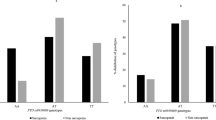Abstract
Background and aims: Sarcopenia is defined as a reduction in skeletal muscle mass, strength, and endurance observed with advancing age. Although Vitamin D receptor (VDR) polymorphism is reported to be associated with muscle mass and strength, evidence for this is limited and conflicting. In this study, we examined the association between the polymorphisms of VDR gene BsmI, TaqI and FokI and muscular mass and strength in elderly men. Methods: This is a cross-sectional study conducted in a university hospital. One hundred and twenty men over 65 years of age participated, all participants were active men living independently in Istanbul, who were followed as outpatients in geriatric polyclinics. Most common diagnoses were hypertension, hyperlipidemia, and mild to moderate osteoarthritis. Morbid obese patients were not included in the study. Genomic DNA was extracted from peripheral blood, and VDR genotypes were determined by the polymerase chain reaction. The peak torque of the knee flexors and extensors was measured on a Cybex 350 dynamometer. Body muscle mass was calculated by using bioelectric impedance analysis. Results: The extensor strength of the knee was higher in BB homozygotic men than in the Bb/bb group. No significant association was found with TaqI and FokI haplotypes. There was no significant association between muscle mass and strength, or between muscle mass and VDR genotype. Conclusion: Our data suggest that VDR gene BsmI polymorphism is associated with muscular strength in elderly men.
Similar content being viewed by others
References
Greenlund LJS, Nair KS. Sarcopenia-consequences, mechanisms, and potential therapies. Mech Ageing Dev 2003; 124: 287–99.
Marceil TJ. Sarcopenia: causes, consequences, and preventions. J Gerontol A Biol Sci Med Sci 2003; 58: M911–6.
Janssen I, Shepard DS, Katzmarzyk PT, Roubenoff R. The healthcare costs of sarcopenia in the United States. J Am Geriatr Soc 2004; 52: 80–5.
Capiati D, Benassati S, Boland RL. l,25(OH)2-vitamin D3 induces translocation of the vitamin D receptor (VDR) to the plasma membrane in skeletal muscle cells. J Cell Biochem 2002; 86: 128–35.
Prabhala A, Garg R, Dandona P. Severe myopathy associated with vitamin D deficiency in western New York. Arch Intern Med 2000; 160: 1199–203.
Ziambaras K, Dagogo-Jack S. Reversible muscle weakness in patients with vitamin D deficiency. West J Med 1997; 167: 435–9.
Roubenoff R, Hughes VA. Sarcopenia: current concepts. J Gerontol Med Sci 2000; 55A: M716–24.
Whitfield GK, Remus LS, Jurutka PW et al. Functionally relevant polymorphisms in the human nuclear vitamin D receptor. Mol Cell Endocrinol 2001; 177: 145–59.
Jurutka PW, Remus LS, Whitfield GK et al. The polymorphic N terminus in human vitamin D receptor isoforms influences transcriptional activity by modulating interaction with transcription factor IIB. Mol Endocrinol 2000; 14: 401–20.
Wang P, Ma LH, Wang HY et al. Association between polymorphism of vitamin D receptor gene Apal, BsmI, and TaqI and muscular strength in young Chinese women. Int J Sports Med 2006; 27: 182–6.
Grundberg E, Brandstrom H, Ribom EL, Ljunggren O, Mallmin H, Kindmark A. Genetic variation in the human vitamin D receptor is associated with muscle strength, fat mass and body weight in Swedish women. Eur J Endocrinol 2004; 150: 323–8.
Geusens P, Vandevyver C, Vanhoof J, Cassiman JJ, Boonen S, Raus J. Quadriceps and grip strength are related to vitamin D receptor genotype in elderly nonobese women. J Bone Miner Res 1997; 12: 2082–8.
Roth SM, Zmuda JM, Cauley JA, Shea PR, Ferrell RE. Vitamin D receptor genotype is associated with fat-free mass and sarcopenia in elderly men. J Gerontol A Biol Sci Med Sci 2004; 59: 10–5.
Windelinckx A, De Mars G, Beunen G et al. Polymorphisms in the vitamin D receptor gene are associated with muscle strength in men and women. Osteoporos Int 2007; 18: 1238–42.
Castillo EM, Goodman-Gruen D, Kritz-Silverstein D, Morton DJ, Wingard DL, Barrett-Connor E. Sarcopenia in elderly men and women: the Rancho Bernardo study. Am J Prev Med 2003; 25: 226–31.
Kushner RF. Bioelectrical impedance analysis: a review of principles and applications. J Am Coll Nutr 1992; 11: 199–209.
Lukaski HC, Johnson PE, Bolonchuck WW, Lykken GI. Assessment of fat-free mass using bioelectrical impedance measurements of the human body. Am J Clin Nutr 1985; 41: 810–7.
Deurenberg P, Andreoli A, Borg P et al. The validity of predicted body fat percentage from body mass index and from impedance in samples of five European populations. Eur J Clin Nutr 2001; 55: 973–9.
Kitano T, Kitano N, Inomoto T, Fatatsuka M. Evaluation of body composition using dual energy X-ray absorptiometry, skin fold thickness and bioelectrical impedance analysis in Japanese female college students. J Nutr Sci Vitaminol (Tokyo) 2001; 47: 122–5.
Baumgartner RN, Koehler KM, Gallagher D et al. Epidemiology of sarcopenia among the elderly in New Mexico. Am J Epidemiol 1998; 147: 755–63.
Onder G, Capoluongo E, Danese P et al. Vitamin D receptor polymorphisms and falls among older adults living in the community: results from the ilSIRENTE study. J Bone Miner Res 2008; 23: 1031–6.
Uitterlinden AG, Fang Y, Van Meurs JB, Pols HA, Van Leeuwen JP. Genetics and biology of vitamin D receptor polymorphisms. Gene 2004; 338: 143–56.
Yamagata M, Nakajima S, Tokita A et al. Analysis of the stable levels of messenger RNA derived from different polymorphic alleles in the vitamin D receptor gene. J Bone Miner Metab 1999; 17: 164–70.
Durrin LK, Haile RW, Ingles SA, Coetzee GA. Vitamin D receptor 3’-untranslated region polymorphisms: lack of effect on mRNA stability. Biochim Biophys Acta 1999; 1453: 311–20.
Carling T, Rastad J, Akerström G, Westin G. Vitamin D receptor (VDR) and parathyroid hormone messenger ribonucleic acid levels correspond to polymorphic VDR alleles in human parathyroid tumors. J Clin Endocrinol Metab 1998; 83: 2255–9.
Author information
Authors and Affiliations
Corresponding author
Rights and permissions
About this article
Cite this article
Bahat, G., Saka, B., Erten, N. et al. BsmI polymorphism in the vitamin D receptor gene is associated with leg extensor muscle strength in elderly men. Aging Clin Exp Res 22, 198–205 (2010). https://doi.org/10.1007/BF03324797
Received:
Accepted:
Published:
Issue Date:
DOI: https://doi.org/10.1007/BF03324797



